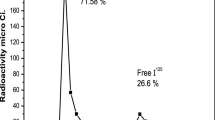Abstract
Human chorionic gonadotropin (hCG) is composed of two non-covalently linked dissimilar glycosylated α and β subunits. The α subunit of hCG is virtually identical to the α subunits of three pituitary gonadotropins, namely hLH, hFSH and hTSH. Biological and immunological specificity of the molecule thus reside in the β subunit. It is normally a product of trophoblast and detectable in the circulation within 8 to 10 days post-fertilization (Catt et al., 1975; Saxena et al., 1974). Studies on human embryos cultured in vitro demonstrated that the synthesis of hormone starts as early as 170 h after fertilization, e.g. in preimplantation embryos (Fishel et al., 1984). Its level, during the first week after the expected menstrual period, i.e. third week of pregnancy, is around 0.3–0.4 IU/ml of blood (Braunstein et al., 1976) with a doubling time of 1.7–2 days in early gestation (Braunstein et al., 1973). It has traditionally been used as an index of pregnancy and is the basis of all available bioassays and immunoassays.
Access this chapter
Tax calculation will be finalised at checkout
Purchases are for personal use only
Preview
Unable to display preview. Download preview PDF.
Similar content being viewed by others
References
Braunstein, G. D., Gordin, J. M., Vaitukaitis, J. L., Ross, G. T. (1973). Secretory rates of human chorionic gonadotropin by normal trophoblast. Am. J. Obstet. Gyn., 115, 447–457.
Braunstein, G. D., Rasor, J., Adler, D., Danzer, H., Wade, M. E. (1976). Serum human chorionic gonadotropin levels throughout normal pregnancy. Am. J. Obstet. Gyn., 126, 678–681.
Catt, K. J., Dufau, M. L., Vaitukaitis, J. L. (1975). Appearance of hCG in pregnancy plasma following the initiation of implantation of the blastocyst. J. Clin. Endocrinol. Metab., 40, 537–540.
Fishel, S. B., Edwards, R. G., Evans, C. J. (1984). Human chorionic gonadotropin secreted by preimplantation embryos cultured in vitro. Science, 223, 816–818.
Guesdon, J. L., Ternyck, T., Avrameas, S. (1979). The use of avidin biotin interaction in immunoenzymatic techniques. J. Histochem. Cytochem., 27, 1131–1139.
Guesdon, J. L., Avrameas, S. (1980). Lectin-immunotest: quantitation and titration of antigens and antibodies using lectin-antibody conjugates. J. Immunol. Methods, 39, 1–13.
Gupta, S. K., Singh, O., Kaur, I., Talwar, G. P. (1985a). Characteristics of monoclonal anti-alpha human chorionic gonadotropin antibody. Indian J. Med. Res., 81, 281–285.
Gupta, S. K., Guesdon, J. L., Avrameas, S., Talwar, G. P. (1985b). Solid-phase sandwich enzyme immunoassays of human chorionic gonadotropin using monoclonal antibodies. J. Immunol Methods, 83, 159–168.
Gupta, S. K., Guesdon, J. L., Avrameas, S., Talwar, G. P. (1985c). Sandwich enzyme immunoassay of human chorionic gonadotropin using polystyrene beads as solid support. Ann Inst. Pasteur Immunol., 136D, 47–55.
Gupta, S. K., Guesdon, J. L., Avrameas, S., Talwar, G. P. (1985d). Solid-phase competitive and sandwich-type erythro-immunoassays for human chorionic gonadotropin. J. Immunol Methods, 80, 177–187.
Gupta, S. K., Talwar, G. P. (1980). Development of hybridomas secreting anti-human chorionic gonadotropin antibodies. Indian J. Exp. Biol., 18, 1361–1365.
Köhler, G., Milstein, C. (1975). Continuous cultures of fused cells secreting antibody of predefined specificity. Nature, 256, 495–497.
Saxena, B. B., Hasan, S. H., Haour, F., Collwitzer, S. M. (1974). Radioreceptor assay of human chorionic gonadotropin: detection of early pregnancy. Science, 184, 793–795.
Talwar, G. P., Gaur, A., Gupta, S. K., Singh, A. K., Paul, S. (1983). A highly sensitive method for detection of human pregnancy and hCG synthesizing tumours in laboratory and field. In Talwar, G. P. (ed), Non-isotopic Immunoassays and their Applications, Vikas Publishing House, India, pp. 188–196.
Editor information
Editors and Affiliations
Copyright information
© 1988 S. B. Pal and the Contributors
About this chapter
Cite this chapter
Gupta, S.K. (1988). Sensitive Enzyme and Erythro Immunoassays for Detection of Human Pregnancy. In: Pal, S.B. (eds) Reviews on Immunoassay Technology. Palgrave Macmillan, London. https://doi.org/10.1007/978-1-349-10318-8_2
Download citation
DOI: https://doi.org/10.1007/978-1-349-10318-8_2
Publisher Name: Palgrave Macmillan, London
Print ISBN: 978-1-349-10320-1
Online ISBN: 978-1-349-10318-8
eBook Packages: Biomedical and Life SciencesBiomedical and Life Sciences (R0)




